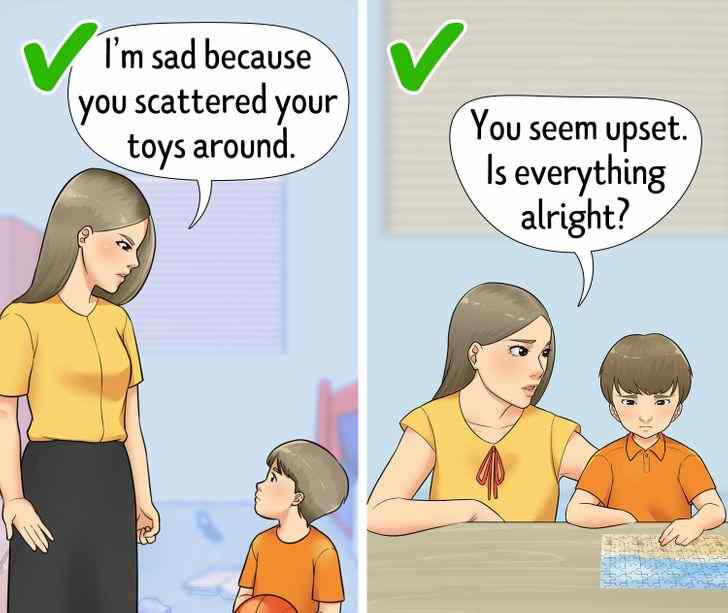
Some children, especially those of a younger age, may struggle to regulate their emotions because they do not yet understand how to discern and control them. As a result, temper tantrums, screaming, and arguing with peers may become a normal occurrence. Although such actions can be frustrating for parents, there are ways to cope with emotional outbursts in children in a safe manner.
1. Teach the child how to mark his or her emotions.

For a child, describing such an abstract concept as feelings can be challenging. However, children rarely progress from being angry to throwing a tantrum. As a result, being able to recognise and suppress negative feelings is beneficial.
Parents can help their children better understand their feelings in a variety of ways:
- Describe your own emotions and why you’re experiencing them. It’s also a good idea to learn about other people’s feelings to help your child develop empathy. “I’m sad because you left your toys in your brother’s room,” for example. I’m sure he’s sad, too, because it’s a shambles in there.”
- Rank the strength of your current emotions. If you notice your child is sad, angry, or upset about something, ask them what they’re feeling and offer to describe the strength of the feeling on a scale of one to ten, along with an explanation of what caused it.
- If you find that certain acts or activities seem to elicit certain emotions in your child, give a hint to help your child understand them. “It seems that collecting this puzzle irritates you,” for example, or “You seem very pleased that we went to see this film.”
2. Explain the distinction between getting feelings and acting on those feelings.

Don’t dismiss or minimise your child’s negative emotions; instead, emphasise that it’s perfectly normal to experience rage, annoyance, irritation, and sadness from time to time. However, there must be a distinction made between getting these feelings and acting on them.
“I understand that you’re upset, but it’s not okay to hit your brother if he refuses to share his toys with you,” for example. Also, don’t forget to suggest a different approach to the dilemma, such as “Don’t hit your brother.” Only speak with him the next time.” Your child should recognise that aggressive actions will not be accepted and that there are other options for dispute resolution.
3. Give the child an opportunity to make a choice.

When children are asked to do things that they dislike, they can throw a tantrum. However, if you want the child to be more receptive to your demands, give them a variety of choices from which to choose. Instead of saying, “After lunch, we’re going to the mall,” suggest, “We can go to the mall together or you can spend time at your grandmother’s while I’m there.”
Allowing your child to make their own decisions and take charge of the situation helps to alleviate anxiety and the likelihood of an emotional outburst. As an added bonus, since you’ve already given the details, you’re less likely to waste time negotiating alternative solutions.
4. Help your child to breathe.

Slow breathing will help your child relax and reverse the stress response when they are experiencing strong emotions. Simply instruct your children to take many long and deep breaths through their nose and out through their mouth.
If your child is having trouble concentrating, make a little game for them to play. You could, for example, ask your child to picture their fingers as candles and have them blow them out one by one.
5. Use a game to divert the child’s attention.

To get your child’s attention, do something spontaneous like switching off the lights or make an odd gesture. Then have them name five red objects in the room or touch three soft objects. Your aim is to divert your child’s attention away from their emotions and toward rationality.
Another technique for releasing negative feelings is to have the child throw a pretend angry stone. Your child should consider their feelings as a ball of energy. Then challenge them to throw it as hard as they can and as high as they can. They’ll be able to release some frustration and feel better as a result of this.
6. Recognize the child’s feelings.

Show your child that you’re really listening to them and that you understand what they’re going through when they tell you about their negative emotions. Your aim is to simply be there for them, not to give them a solution to their dilemma or to pass judgement on them. Avoid using generic responses like “Uh-huh” or “Really?” Instead, try to think of something more thoughtful to say.
It could be a good idea, for example, to paraphrase your child’s thoughts. When your child complains about their math homework, for example, you may respond by saying, “Wow, you have so many tasks to complete today!” You could also encourage your child by saying, “You’re a natural at math.” I admire how you still find new ways to solve all of these math problems.”
Make sure you’re talking to your kid at the same eye level as them. You’ll give your child a sense of control over the situation and they’ll see that you’re paying attention to them.
7. Make a conscious effort to disregard negative actions.

However, remember that recognising your child’s negative feelings does not imply that you accept and reward their bad conduct. When your child is desperate for your attention, he or she will misbehave. Your child will purposefully talk back, use offensive language, complain, or act overly dramatic so they know you’ll respond.
Ignore your child’s actions for a while if you catch them acting out. You should, for example, turn away and wait for the action to end. However, if your child does something for which you want to express your gratitude, pay close attention to them right away.
8. Be prepared for activities that can cause you to experience negative emotions.

If you know your child is going to experience something negative or that will cause them to have intense emotional outbursts, help them prepare for it ahead of time. If you know your child is scared of going to the doctor, for example, remind them about the medical checkup you planned ahead of time.
You can remember the last time you were at the doctor’s office together and the feelings you had. Discuss what you can do to make your child’s experience more fun and how you can help them cope with their emotions. This way, you’ll be able to devise a strategy for turning a negative scenario into a constructive one.
